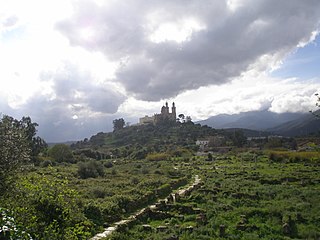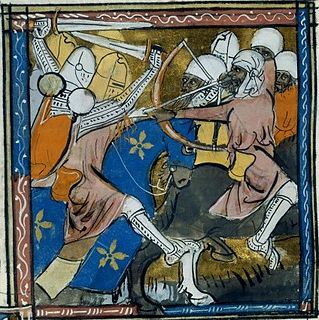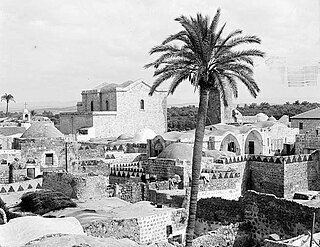
Hippo Regius is the ancient name of the modern city of Annaba, Algeria. It historically served as an important city for the Phoenicians, Berbers, Romans, and Vandals. Hippo was the capital city of the Vandal Kingdom from 435–439 C.E. until it was shifted to Carthage following the Vandal Capture of Carthage (439).

Lod is a city 15 km (9.3 mi) southeast of Tel Aviv in the Central District of Israel. In 2019 it had a population of 77,223.

Bohemond III of Antioch, also known as Bohemond the Child or the Stammerer, was Prince of Antioch from 1163 to 1201. He was the elder son of Constance of Antioch and her first husband, Raymond of Poitiers. Bohemond ascended to the throne after the Antiochene noblemen dethroned his mother with the assistance of Thoros II, Lord of Armenian Cilicia. He fell into captivity in the Battle of Harim in 1164, but the victorious Nur ad-Din, atabeg of Aleppo released him to avoid coming into conflict with the Byzantine Empire. Bohemond went to Constantinople to pay homage to Manuel I Komnenos, who persuaded him to install a Greek Orthodox Patriarch in Antioch. The Latin Patriarch of Antioch, Aimery of Limoges, placed Antioch under interdict. Bohemond restored Aimery only after the Greek patriarch died during an earthquake in 1170.
Eustace I Garnier, also known as Eustace Grenier or Eustace Granarius, was Lord of Caesarea from before 1110, and Lord of Sidon from 1110 to his death. He was a nobleman from the County of Saint-Pol and went to the Holy Land either during the First Crusade or around 1100. He became an influential retainer of King Baldwin I of Jerusalem, who granted Caesarea and Sidon to him. After an Artuqid prince captured Baldwin I's successor, Baldwin II, Eustace was elected constable and bailiff in April 1123. Shortly before his death in 1123, he defeated a Fatimid army as the Battle of Yibneh near Ibelin.
Ramatha is the name of a former Roman Catholic titular bishopric in Palestine.
Roman of Le Puy, also known as Romanus of Puy, was the first lord of Oultrejordain in the Kingdom of Jerusalem from around 1120 to around 1126. He was a nobleman from Auvergne who accompanied Adhemar de Monteil, Bishop of Le Puy, to the Holy Land during the First Crusade. He signed royal charters during the reign of Baldwin I of Jerusalem. Baldwin I or his successor, Baldwin II of Jerusalem, granted Roman the important fief of Oultrejordain, or its northern region. He was deprived of most of his domains because of a rebellion against Baldwin II. He and his son lost their remaining estates after they were accused of conspiring against Baldwin II's successor, Fulk of Anjou, in the early 1130s.

Hugh of Fauquembergues, also known as Hugh of St Omer, Hugh of Falkenberg, or Hugh of Falchenberg was Prince of Galilee from 1101 to his death. He was Lord of Fauquembergues before joining the First Crusade. Baldwin I of Jerusalem granted him Galilee after its first prince, Tancred, who was Baldwin's opponent, had voluntarily renounced it. Hugh assisted Baldwin against the Fatimids and made raids into Seljuk territories. He established the castles of Toron and Chastel Neuf. He died fighting against Toghtekin, Atabeg of Damascus.

Diocese of Lydda (Lod) is one of the oldest Bishoprics of the early Christian Church in the Holy Land. Suppressed under Persian and Arab-Islamic rule, it was revived by the Crusaders and remains a Latin Catholic titular see.

The historiography of the Crusades has been subject to competing and evolving interpretations from the First Crusade in 1096 until the present day. Originally intended as a way to re-direct Western military efforts from fighting other Christians and into the conquest and retention of the Holy Land, they were later used in other areas of interest to the Catholic Church.

The Diocese of Castello, originally the Diocese of Olivolo, is a former Roman Catholic diocese that was based on the city of Venice in Italy. It was established in 774, covering the islands that are now occupied by Venice. Throughout its existence there was tension between the diocese, the Patriarchate of Grado to which it was nominally subordinate, and the Doge of Venice. Eventually in 1451 the diocese and the patriarchate were merged to form the Archdiocese of Venice.

The timeline of the Kingdom of Jerusalem presents important events of the history of the Kingdom of Jerusalem—a crusader state in Palestine—in chronological order. The kingdom was established during the First Crusade. Its first ruler, Godfrey of Bouillon, was not crowned king and swore fealty to the Latin Patriarch of Jerusalem, Daimbert in 1099. Godfrey's brother and successor, Baldwin I, who did not acknowledge the patriarchs' sovereignty, was crowned the first king of Jerusalem in 1100. Baldwin I and his successors captured all towns on the coast with the support of Pisan, Genoese and Venetian fleets and also took control of the caravan routes between Egypt and Syria. The kings regularly administered other crusader states—the Counties of Edessa and Tripoli, and the Principality of Antioch—on behalf of their absent or minor rulers.
Simeon II or Symeon II was the Greek Orthodox Patriarch of Jerusalem from the 1080s to 1099.
The Roman Catholic Diocese of Sidon was a bishopric in the Kingdom of Jerusalem in the 12th and 13th centuries.

The timeline of the Principality of Antioch is a chronological list of events of the history of the Principality of Antioch.
Robert of Rouen was the first bishop of Lydda and Ramla from 1099.
Bursuq ibn Bursuq, also known as Bursuk ibn Bursuk, was the emir of Hamadan.
The Roman Catholic Archdiocese of Apamea was an ecclesiastical province of the Catholic Church in the Principality of Antioch from around 1110 to 1149.
The siege of Aleppo by Baldwin II of Jerusalem and his allies lasted from 6 October 1124 to 25 January 1125.
William I was the second Latin archbishop of Tyre from 1128 until 1134 or 1135. He was an Englishman who served as prior of the Church of the Holy Sepulchre before his appointment as archbishop.
Roger was the second bishop of Lydda and Ramla from at least 1112 until 1147.







